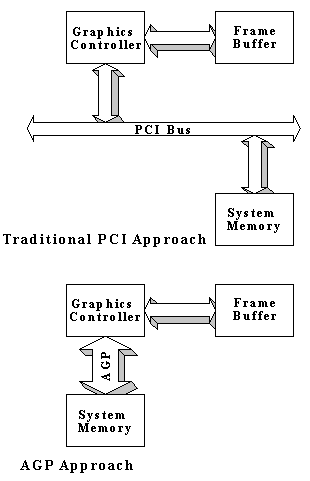The Accelerated
Graphics Port (AGP)
- A Diamond Multimedia White Paper
The PC bus has gone through many changes as the demands
placed on it have increased. The original PC expansion
bus was the Industry Standard Architecture (ISA) which
despite its limitations is still used for predominantly
low-bandwidth peripherals such as Sound Blaster audio.
The Peripherals Connection Interface (PCI) standard
replaced the VESA VL bus specification, and has been the
standard system bus for high-performance peripherals such
as disk controllers and graphics boards. However, the
emergence of 3D graphics threatened to overload the PCI
bus.
The accelerated graphics port (AGP) is an extension of
the PCI bus which addresses the limitations of PCI for
handling large amounts of 3D graphics data. Intel
developed AGP to address two problems facing 3D graphics
on PCI. Firstly, 3D graphics requires as much memory as
possible for texture maps and z-buffer information. The
more texture maps available to a 3D application, the
better looking the final results. Under normal
circumstances the z-buffer, which provides information
relating to the depth of a scene, uses the same memory as
textures. This conflict creates a number of trade-offs
for 3D developers as they grapple with the high cost of
texture and z-buffer memory, and the results have an
impact on the quality of the final image.
Designers of PCs have in the past suggested system
memory be used for the storage of texture and z-buffer
information, but the limitation on such a solution has
been the transfer of such information across the PCI bus.
The graphics subsystem and system memory are constrained
by the physical limitations of the PCI bus. In addition,
the bandwidth, or capacity, of PCI is not sufficient for
real-time graphics. To help address these problems Intel
has developed AGP.
 AGP is,
in very simple terms, a direct connection between the
graphics subsystem and system memory. It provides much
higher data transfer rates than PCI, and was expressly
designed to meet the demands of real-time 3D. AGP allows
for efficient use of frame buffer memory, thereby helping
2D graphics performance as well, while increasing the
flow of 3D data through the system. AGP is,
in very simple terms, a direct connection between the
graphics subsystem and system memory. It provides much
higher data transfer rates than PCI, and was expressly
designed to meet the demands of real-time 3D. AGP allows
for efficient use of frame buffer memory, thereby helping
2D graphics performance as well, while increasing the
flow of 3D data through the system.
The definition of AGP, as a seemingly direct
connection between graphics subsystem and system memory,
is referred to as a point-to-point connection. In
reality, AGP connects the graphics subsystem to the
electronic logic of system memory, a position shared by
the CPU.
AGP has only one upgrade path as a result, the
graphics board. Motherboard graphics solutions using AGP
will not be upgradeable.
Texture Mapping Performance
Intel's determination to ensure that AGP becomes a
standard results from the realization that without such a
solution, optimal 3D performance is difficult to achieve
on the PC. Real-time 3D graphics requires a large amount
of data to flow through the graphics subsystem. Without
AGP solutions exotic memory devices, which are expensive
to implement, would be required. In AGP designs texture
memory and z-buffer data can be stored in system memory.
With more effective use of system memory, AGP graphics
boards do not require local texture memory, and can be
provided at much lower costs.
In theory PCI would have been able to perform the same
functions of AGP, but the performance would have been
insufficient for most applications. Intel designed AGP
for 133 MHz data rates, and manages memory in a complete
different way than PCI. In PCI, any information stored in
system memory is not physically continuous. This means
there is a performance lag as information is gathered
from its physical residence in system memory, and
delivered in an orderly way to the graphics subsystem.
With AGP, Intel has created a mechanism whereby the
physical address of information in system memory is
immaterial to the graphics subsystem. This is a key issue
when an application is also using system memory to store
and retrieve information. In the AGP design, no matter
how texture data is scattered, the graphics subsystem can
retrieve it seamlessly.
Intel expects AGP penetration will reach 90% of all
systems by the end of the century. The computer graphics
industry, both hardware and software development
communities, have adopted the AGP specification. Unlike
PCI, where many devices vie for control of the bus, in
AGP the only device is a graphics subsystem. Initially,
in the middle of 1997, Intel will ship AGP motherboards
for Pentium Pro systems. Within a matter months, the
Pentium AGP motherboards will also be available, and by
the end of 1997 AGP will proliferate on many of the PCs
being sold.
Diamond's AGP Strategy
AGP is a bus design which overcomes the limitations of
the PCI bus to transfer data in and out of system memory.
AGP improves on the physical speed of transfer by
operating at 133 MHz, compared with the 66 MHz of PCI,
and AGP provides a coherent memory management design
which allows scattered data in system memory to be read
in rapid bursts. AGP helps not only increase the
performance of real-time 3D by delivering
high-performance textures, but it reduces the overall
cost of creating high-end graphics subsystems by using
existing system memory architectures.
Diamond will provide AGP products designed to take
full advantage of this exciting new bus for 3D graphics.
Diamond is ideally suited to take advantage of the
benefits of AGP because of the company's rich set of 3D
and 2D graphics controllers, high-performance drivers
designed for AGP, and a complete understanding of the
benefits AGP provides to the consumer.
|


